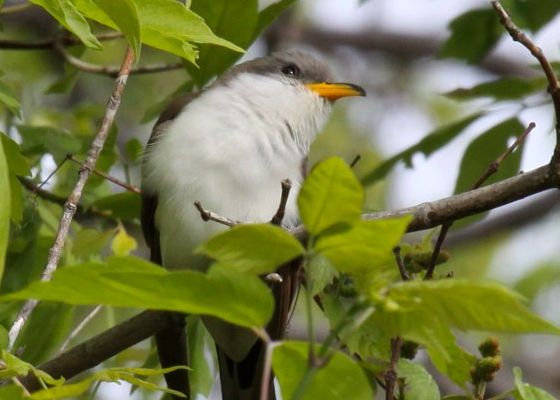
Why is this bird in such a hurry to migrate south in mid-summer after raising only one brood in North America?
The answer is a surprise. It turns out that some yellow-billed cuckoos raise a second family in the thorn forests of western Mexico. And so do orchard orioles, hooded orioles, yellow-breasted chats and Cassin’s vireos.
Called “migratory double breeding” the discovery was stunning. Scientists knew of just two Old World species who did this on their journey north but no birds had been found to do it in the western hemisphere and none anywhere were known to double-breed on the southbound trip.
Gathering the evidence was truly detective work. Scientists were in the thorn forests in July and August, expecting to study the molt cycles of migratory songbirds. Instead they found males singing on territory, female birds with established brood patches and no young birds as they’d expect if the families had already bred in the forest. The clincher was when they found the nests and eggs.
If five songbird species are double-breeding in the thorn forest, why did it take so long to discover it? July and August are forbidding months in western Mexico. It’s the monsoon season with temperatures at 100 degrees, humidity at 100% and lots of biting insects. People have only recently begun to farm the region, leading to a decline in thorn forest habitat. Interestingly, the habitat decline coupled with migratory double-breeding may explain the decline of yellow-billed cuckoos in the western U.S.
So like the story of a man who has two families half a continent apart, these birds must hurry to squeeze in a second family in western Mexico, then finish their migration to tropical Central and South America. That’s what the rush is all about.
Read more about the discovery in this Science Daily article.
(photo by Chuck Tague)
Sometimes we don’t realize that any of these birds are around until we find a dead one. I found the body of a yellow-billed cuckoo in Oakland (Pittsburgh’s University district). It struck me so odd as I had never seen a live one. This occurred about ten years ago. I found the body of a Yellow-bellied Sapsucker in the Hill District. I found a rose-breasted grosbeak in Bloomfield (all Pittsburgh neighborhoods). I never knew these birds were there.